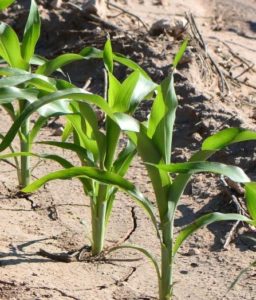by Jourdan Bell, Texas A&M AgriLife Assistant Professor and Agronomist – Amarillo
Post emergent herbicide applications are necessary for season long weed control. Post emergent corn herbicide labels define the latest growth stage for which herbicide applications can be made without causing crop injury. Herbicide applications past the recommended application stages can result in significant crop injury. For some herbicides, later applications can be made according to the label, but drop nozzles are recommended to prevent herbicides being sprayed in the whorl. Some herbicide labels provide a recommended height for the last herbicide application as plant height often corresponds with a particular vegetative stage. However, in high input environments with abundant irrigation and/or precipitation and fertility, internode distances can expand at a greater rate than new leaves. Consequently, plant height does not always correspond to the correct vegetative stage so, it is important to accurately stage the corn crop prior to making post emergent herbicide applications. In stressful production environments with limited water or cool temperatures, corn growth is slowed, which results in magnified crop injury because the plant does not metabolize the herbicide quickly enough to avoid injury. For labels that provide both plant height and growth stage, the applicator should follow the more conservative recommendation. Non-labeled spray adjuvants can enhance herbicide injury from a post emergent application. In addition to the crop stage and condition, knowledge of the weed species and weed size are also important for effective post emergent herbicide applications. The vegetative stage are described using the leaf collar method (Table 1). Leaves are counted from the lowermost first (rounded-tip) leaf to the uppermost leaf with a leaf collar, which is the connection between the leaf blade and the leaf sheath. The leaves in the whorl that are not fully expanded are not counted.
Table 1. Corn vegetative growth stages noted as “V” stages important for herbicide application timing.
| Emergence(VE)
|
Coleoptile leaf (1st leaf) visible. This leaf will be shorter than later emerging leaves and has a rounded tip. Also referred to as spike. |
| Growing point of the plant should be 1 to 1.75 inches below the soil surface. Seminal roots begin growing from the seed. Permanent (nodal) root system will begin developing at this point. If seed is planted too shallow the root system will have a difficult time becoming established. | |
| 2‐Leaf (V2) | Collar of the 2nd true leaf is visible. Plant is still relying primarily on seed reserves for survival. |
| 3‐Leaf (V3)
|
Collar of 3rd leaf visible. Occurs approximately 10 to 14 days after emergence. |
| Growing point below the soil surface. The plants total leaf number and ear shoot are developing in the stalk. | |
| Photosynthesis now very active and supporting the plant. | |
| May apply 2,4‐D or dicamba from emergence through the 5th leaf stage without drop nozzles. | |
| Begin checking roots for Western corn rootworm larvae (white). Watch corn that is next to wheat or grass for Banks grass mites infesting lower surface of leaves. | |
| 4‐Leaf (V4)
|
Collar of 4th leaf visible. |
| Growing point below the soil surface. | |
| Roots are elongating. The roots system is nor primarily nodal roots. | |
| Weed competition will begin to significantly reduce yield potential. | |
| 5‐Leaf (V5)
|
Collar of 5th leaf visible. May have lost the coleoptile leaf by this time. |
| Leaf number and ear shoot formation is now complete. | |
| Plant is approximately 8 inches tall. Growing point is just below the ground surface. A hail or light freeze will cause little long‐term damage to the plant. However, flooding while the growing point is below ground can kill the plant, especially if temperatures are high. | |
| The first internode to elongate is approximately 0.5 inch long and is located just below the node to which leaf 5 is connected. This is an important reference for crop growth staging. | |
| Tassel formation has been initiated. | |
| 6‐Leaf (V6)
|
Collar of 6th leaf visible. Occurs approximately 3‐weeks after emergence. |
| Growing point and tassel above soil surface making the plant more vulnerable to a hail or freeze. | |
| Permanent root system rather than the seminal roots is now the primary root system supporting the plant. Root system extends approximately 18 inches. | |
| 7‐Leaf (V7)
|
Collar of 7th leaf visible. Plant beginning to grow rapidly. |
| The number of kernel rows being determined from V7 to V8. Maximum row set by V8. | |
| 8‐Leaf (V8) | Collar of 8th leaf visible. Occurs approximately 45 days after emergence. Plants may have lost lower two leaves. |
| 9‐Leaf (V9)
|
Collar of 9th leaf visible. Ear shoots are visible in the leaf collar regions. May have up to
8 ear shoots. |
| Tassel is rapidly developing. | |
| 10‐Leaf (V10)
|
Collar of 10th leaf visible. New leaf stage occurring every 3 to 4 days. |
| Water and nutrient demands are high. | |
| 11‐Leaf (V11) | Collar of 11th leaf visible. May have lost lower three leaves. |
| 12‐Leaf (V12) | Collar of 12th leaf visible. |
| Approximately 6 weeks after planting. | |
| 13‐17 Leaves (V13‐V17) | V17 is approximately 8 weeks after emergence. |
| Leaf stages 13 to 17 will develop very rapidly. At some point the tip of the tassel will be visible. | |
| Early maturing hybrids progress from the 13‐leaf stage through the 17‐leaf stage faster than later maturing hybrids and have smaller ears. | |
| Brace roots developing from the 6th node. | |
| Tassel (VT) | Tassel is fully emerged 2 to 3 days prior to silking. |
| Plant is at full height and all leaves have emerged. |
Table 2. Postemergence herbicide labeled growth stages for common corn herbicides.
| Herbicide | Primary Active Ingredient(s) | Labeled corn growth stage and/or plant height |
| Acuron | bicyclopyrone + mesotrione + Smetolachlor + atrazine | Up to 12″ corn |
| Anthem Maxx | pyroxasulfone + fluthiacet‐methyl | Spike through V4 |
| Armezon Pro | isoxoflutole + thiencarbazonemethyl | Spike through V8 or 30″ tall corn |
| Atrazine | Atrazine | Up to 12″ corn |
| Banvel | dicamba | Apply from spike through V5 or 8” tall. After V5 or at heights between 8 and 36″ and up to 15 days before tassel, reduce rate to apply 0.5 pt/acre. Growth regulator herbicides applied after V5 make crop more susceptible to green snap (brittle snap) injury. |
| Basagran | bentazon | No height or growth stage restriction on label |
| Basis Blend | rimsulfuron + thifensulfuron | Spike through V2 corn |
| Beacon | primisulfuron | Apply between 4″ and 20” tall corn. Use drop nozzles when corn is taller than 20” and before tassel emergence |
| Cadet | fluthiacet methyl | Applications can be made prior to tasseling or until crop is 48″ tall |
| Callisto | mesotrione | Up to V8 or 30” corn |
| Capreno | tembotrione + thiencarbazonemethyl | V1 through V8 |
| DiFlexx/DiFlexx Duo | dicamba | Spike through V6 or 36″ corn |
| Glyphosate (Various Products) | glyphosate | Up to V8 or 30” corn. Use drop nozzles for corn 30 to 48” tall |
| Halex GT | mesotrione + S‐metolachlor + glyphosate | Up to V8 or 30” corn |
| Harmony Extra SG | thifensulfuron + tribenuron | V2 through V6 or 16″ tall corn |
| Impact Z | topramezone + atrazine | Labeled for applications up to 45 days before harvest. |
| Laudis | tembotrione | V1 through V8 corn |
| Liberty | glufosinate | Preplant to V7 growth stage or 24″. Use drop nozzles for corn 24–36” tall. |
| Permit | halosulfuron | Spike through layby |
| Realm Q | mesotrione + rimsulfuron | Preplant burndown up to V6 or 20” tall |
| Resicore | mesotrione + acetochlor + clopyralid + | Preplant to 11″ tall |
| Solstice | mesotrione + fluthiacet methyl | Spike through V8 or 30” tall corn |
| Starane NXT | bromoxynil + fluroxypyr | V1 through V5 corn |
| Status | dicamba | V2 through V8 or 36″ tall corn. Growth regulator herbicides applied after V5 make crop more susceptible to green snap (brittle snap) injury. |
| Steadfast Q | nicosulfuron + rimsulfuron | Preplant through V6 or 20” tall |
| Yukon | halosulfuron + dicamba | Spike to 36” tall. Use drop nozzles for corn greater 20” tall |
| Zemax | mesotrione + S‐metolachlor | Spike through V8 or 30” tall |
| 2,4‐D | 2,4‐D | Use drop nozzles when corn is taller than 8”. Growth regulator herbicides applied after V5 make crop more susceptible to green snap (brittle snap) injury. |

Jourdan Bell
Assistant Professor and Extension Agronomist
Dept. of Soil&Crop Sciences
jourdan.bell@ag.tamu.edu

